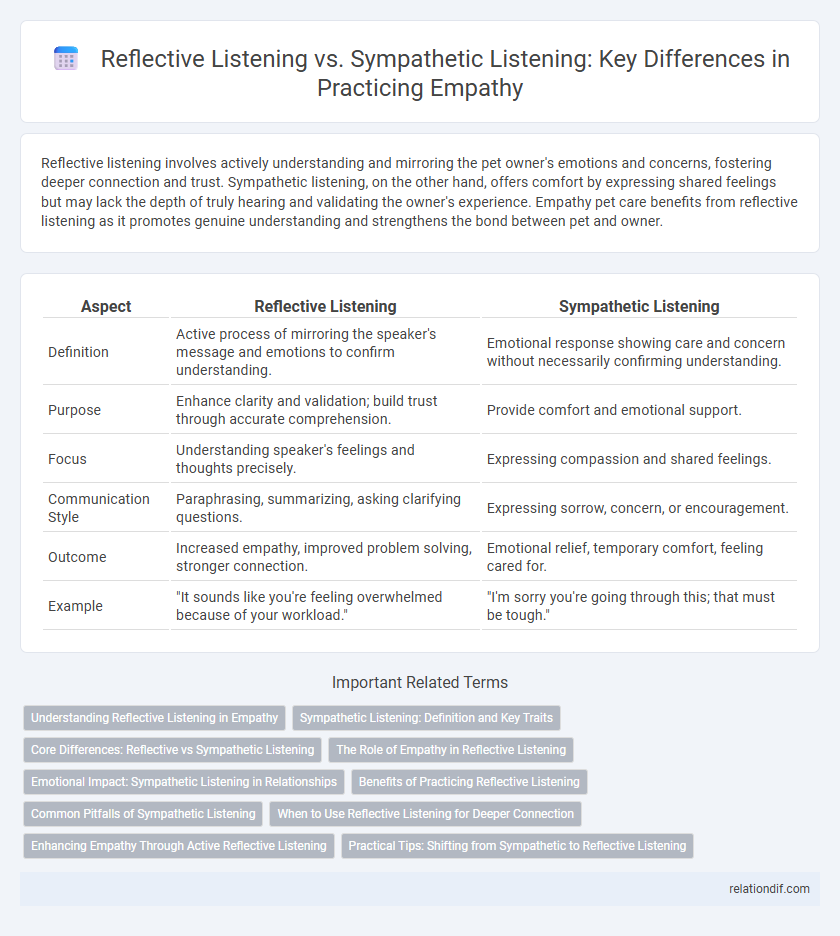Reflective listening involves actively understanding and mirroring the pet owner's emotions and concerns, fostering deeper connection and trust. Sympathetic listening, on the other hand, offers comfort by expressing shared feelings but may lack the depth of truly hearing and validating the owner's experience. Empathy pet care benefits from reflective listening as it promotes genuine understanding and strengthens the bond between pet and owner.
Table of Comparison
| Aspect | Reflective Listening | Sympathetic Listening |
|---|---|---|
| Definition | Active process of mirroring the speaker's message and emotions to confirm understanding. | Emotional response showing care and concern without necessarily confirming understanding. |
| Purpose | Enhance clarity and validation; build trust through accurate comprehension. | Provide comfort and emotional support. |
| Focus | Understanding speaker's feelings and thoughts precisely. | Expressing compassion and shared feelings. |
| Communication Style | Paraphrasing, summarizing, asking clarifying questions. | Expressing sorrow, concern, or encouragement. |
| Outcome | Increased empathy, improved problem solving, stronger connection. | Emotional relief, temporary comfort, feeling cared for. |
| Example | "It sounds like you're feeling overwhelmed because of your workload." | "I'm sorry you're going through this; that must be tough." |
Understanding Reflective Listening in Empathy
Reflective listening enhances empathy by actively mirroring the speaker's emotions and content, fostering a deeper connection and understanding. It involves paraphrasing and validating feelings to ensure clarity and emotional resonance, promoting trust and open communication. This approach contrasts with sympathetic listening, which may acknowledge emotions but lacks the interactive feedback that builds true empathetic comprehension.
Sympathetic Listening: Definition and Key Traits
Sympathetic listening involves understanding another person's feelings by sharing their emotional experience, often expressing concern or sorrow. Key traits include emotional resonance, verbal affirmations of care, and a focus on comfort rather than problem-solving. This form of listening fosters emotional connections by validating feelings and offering support without judgment.
Core Differences: Reflective vs Sympathetic Listening
Reflective listening involves actively understanding and mirroring the speaker's emotions and thoughts to validate their experience, whereas sympathetic listening focuses on feeling compassion and offering comfort without necessarily confirming the speaker's feelings. Core differences highlight that reflective listening prioritizes empathy through accurate emotional reflection, while sympathetic listening centers on expressing pity or concern. This distinction impacts communication effectiveness by fostering trust and deeper connection in reflective listening compared to surface-level reassurance in sympathetic listening.
The Role of Empathy in Reflective Listening
Reflective listening involves fully understanding and mirroring the speaker's emotions and thoughts, highlighting the central role of empathy in accurately interpreting and validating their experience. Empathy enables reflective listeners to connect deeply by acknowledging feelings without judgment, fostering trust and emotional safety. This contrasts with sympathetic listening, which often expresses pity rather than feeling with the speaker, limiting genuine emotional resonance.
Emotional Impact: Sympathetic Listening in Relationships
Sympathetic listening fosters emotional connection by acknowledging and validating the speaker's feelings, which helps build trust and intimacy in relationships. It provides comfort and reassurance, reducing feelings of isolation during emotional distress. This empathetic engagement enhances relational bonds and promotes emotional healing.
Benefits of Practicing Reflective Listening
Reflective listening enhances understanding by actively confirming the speaker's message, fostering deeper emotional connections and trust. It promotes effective communication by encouraging clarity and reducing misunderstandings, which strengthens relationships in both personal and professional settings. Practicing reflective listening also supports emotional validation, helping speakers feel heard and valued, leading to improved conflict resolution and collaboration.
Common Pitfalls of Sympathetic Listening
Sympathetic listening often leads to common pitfalls such as premature judgment, offering unsolicited advice, and minimizing the speaker's emotions, which can hinder genuine connection and trust. Unlike reflective listening, sympathetic listening may focus more on providing comfort rather than truly understanding the speaker's perspective. This approach risks alienating the speaker by failing to validate their feelings and experiences fully.
When to Use Reflective Listening for Deeper Connection
Reflective listening should be used in situations that require deeper emotional understanding and validation, such as counseling, conflict resolution, or intimate conversations, where the speaker needs to feel genuinely heard and supported. This technique involves paraphrasing and mirroring the speaker's feelings and thoughts to foster trust and clarity, promoting empathy and strengthening interpersonal bonds. Unlike sympathetic listening, which offers consolation, reflective listening encourages active engagement and helps uncover underlying emotions for a more meaningful connection.
Enhancing Empathy Through Active Reflective Listening
Active reflective listening enhances empathy by deeply engaging with the speaker's emotions and thoughts, fostering genuine understanding and connection. This technique involves mirroring the speaker's feelings and clarifying their message, which validates their experience and builds trust. Unlike sympathetic listening, which may express pity, reflective listening prioritizes accurate emotional resonance, leading to stronger interpersonal bonds and effective communication.
Practical Tips: Shifting from Sympathetic to Reflective Listening
Shifting from sympathetic to reflective listening involves actively paraphrasing the speaker's emotions and thoughts to validate their experience rather than simply expressing pity. Practical tips include maintaining eye contact, asking open-ended questions, and summarizing key points to show understanding. This approach fosters deeper empathy and encourages honest communication, improving relational trust and emotional connection.
Reflective listening vs Sympathetic listening Infographic

 relationdif.com
relationdif.com